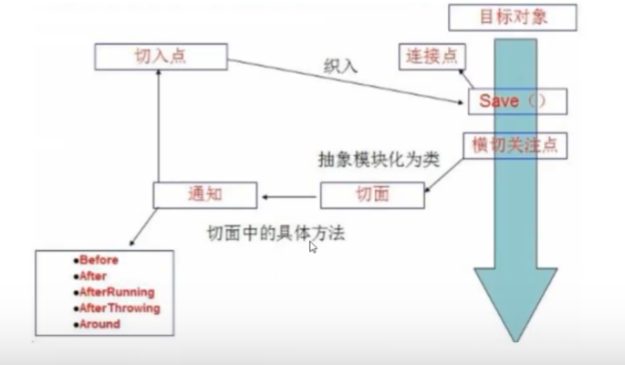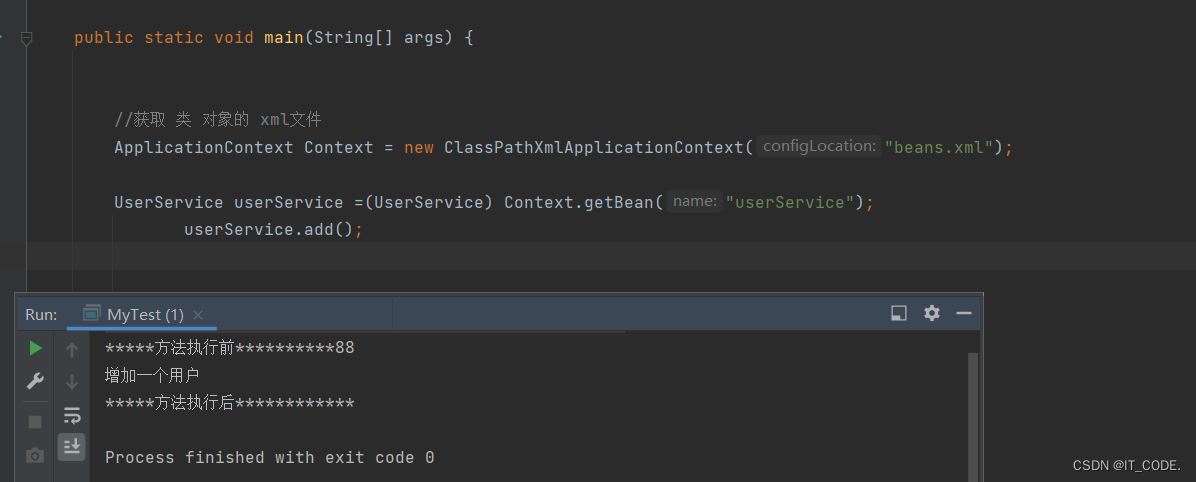aop在spring中的作用
- 提供声明式事务,允许用户自定义切面
- 横切关注点:跨域引用程序多个模块的方法或功能,即是,与我们业务逻辑无关的,但是我们需要
- 关注的部分,就是横切关注点,如日志,安全,缓存,事务等等。
- 切面:aspect :横切关注点,被模块化的特殊对象,即,它是一个类
- 通知:切面必须要完成的工作,它是类中一个方法
- 目标:被通知对象
- 代理:向目标对象引用通知之后创建的对象,
- 切入点:切面通知执行的地点的定义,
- 连接点:与切入点匹配的执行点。
如图所示:

即:可以理解为在不改变原有的代码的情况下,去增加新的功能。
添加依赖:
<dependency>
<groupId>org.aspectj</groupId>
<artifactId>aspectjweaver</artifactId>
<version>1.9.4</version>
</dependency>
第一种方式:
首先编写我们的业务接口和实现类
public interface UserService {
//增
public void add();
//删除
public void delete();
//改
public void update();
// 查
public void select();
}
实现类
public class UserServiceImpl implements UserService{
@Override
public void add() {
System.out.println("增加一个用户");
}
@Override
public void delete() {
System.out.println("删除了一个用户");
}
@Override
public void update() {
System.out.println("更新了一个用户");
}
@Override
public void select() {
System.out.println("查询了一个用户");
}
}
然后去写我们的增强类,编写两个一个前置增强,一个后置增强。
前置增强:
public class Log implements MethodBeforeAdvice {
//重写接口抽象方法 method 要执行的目标对象的方法
@Override
public void before(Method method, Object[] args, Object target) throws Throwable {
// 参数 //目标对象
// 获取反射对象 然后.getname()
System.out.println(target.getClass().getName()+""+"的"+method.getName()+"被执行了");
}
}
后置增强:
public class AfterLog implements AfterReturningAdvice {
@Override
public void afterReturning(Object returnValue, Method method, Object[] args, Object target) throws Throwable {
System.out.println("执行了"+method.getName()+"方法,返回的结果为:"+returnValue);
}
}
最后在去spring中注册,并且实现aop切入实现,并且导入约束。
<?xml version="1.0" encoding="UTF-8"?>
<beans xmlns="http://www.springframework.org/schema/beans"
xmlns:xsi="http://www.w3.org/2001/XMLSchema-instance" xmlns:aop="http://www.springframework.org/schema/aop"
xsi:schemaLocation="http://www.springframework.org/schema/beans
http://www.springframework.org/schema/beans/spring-beans.xsd http://www.springframework.org/schema/aop http://www.springframework.org/schema/aop/spring-aop.xsd">
<aop:config>
<!--切入点,expression :表达式,execution 要执行的位置 -->
<aop:pointcut id="pointcut" expression="execution(* com.kuang.service.UserServiceImpl.*(..))"/>
<!-- 执行环绕增加 -->
<aop:advisor advice-ref="log" pointcut-ref="pointcut"/>
<aop:advisor advice-ref="afterLog" pointcut-ref="pointcut"/>
</aop:config>
</beans>
测试结果:

第二种方式:
自定义类来实现:
目标业务不变依旧是:userServiceImpl
第一步:写我们自己的一个切入类,
// 自定义一个类,变成他的切面。
public class DiyPointCut {
public void before(){
System.out.println("*****方法执行前**********88");
}
public void after(){
System.out.println("*****方法执行后************");
}
}
到spring中去配置:
<!-- 方式二:自定义类 -->
<bean id="diy" class="com.kuang.diy.DiyPointCut"/>
<aop:config>
<!-- 自定义切面,ref 要引用的类 -->
<!--把这个类 标记成切面 -->
<aop:aspect ref="diy"
>
<!--切入点 -->
<aop:pointcut id="point" expression="execution(* com.kuang.service.UserServiceImpl.*(..))"/>
<!--通知 -->
<aop:before method="before" pointcut-ref="point"/>
<aop:after method="after" pointcut-ref="point"/><!--pointcut-ref 在这个切入点,执行-->
</aop:aspect>
</aop:config>
测试结果:

'






















 816
816

 被折叠的 条评论
为什么被折叠?
被折叠的 条评论
为什么被折叠?








